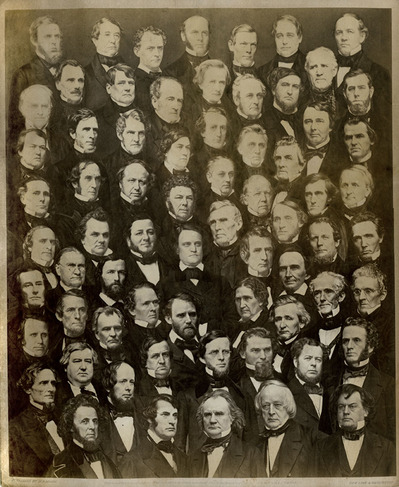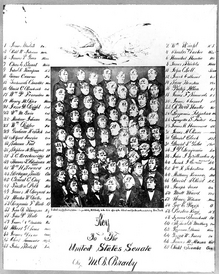Mathew Brady (1822-1896), Composite of the Members of The United States Senate, 1859. Salted paper print, 11.75 x 9.5 inches on mount trimmed to 12.5 x 10 inches. Graphic Arts GA 2011- in process
Mathew Brady was the most celebrated of the early American photographers. In 1844, he opened his first commercial studio in New York City and added a Washington D.C. branch in 1856. His success was, at least in part, thanks to the expert operators he employed, included Alexander Gardner, Timothy H. O’Sullivan, George N. Barnard, among others. Many of these men left Brady’s studio during the Civil War and a few years later, Brady was forced to declare bankruptcy. He was never able to regain his early success and died penniless.
Princeton’s graphic arts collection has acquired a salt print composite of the United States Senate; one of only three known imperial prints of this historic image. To create the print, Brady and his operators photographed each member of the Senate individually, then cut and collaged the photographs and finally, re-photographed the composite.
It would have been worth the trouble, had South Carolina not seceded from the Union shortly after the composite was finished. By the time Brady was ready to sell copies of this photograph, it was already out of date.
Only two other copies have been located, thanks to the research of William Becker. One is in the Prints & Photographs Division of the Library of Congress. That print carries the handwritten notation, “Deposited in Clerk’s office Southern Dist. New York Sept. 20, 1859.” Library of Congress also holds a copy negative of the “key,” a reduced-size copy identifying each of the sitters (copied here on the left).
The other copy of Brady’s Senate photograph is owned by the New-York Historical Society.
The print now at Princeton University was originally the property of U. S. Rep. Henry Waldron (1819-1881), six term Congressman from Hillsdale, Michigan.
Becker has also identified ten of the fourteen members seen in Brady’s composite as ones who were expelled from the Senate for supporting the Confederate rebellion. At least twelve others resigned or withdrew after their states seceded from the union. The composite also depicts Sam Houston of Texas, who served in the US Senate from 1846 to March 4, 1859; Sen. Hannibal Hamlin of Maine, who resigned January 17, 1861 to become Vice President of the United States under Lincoln; and Sen. David C. Broderick of California, who died September 16, 1859 after being mortally wounded in a duel with the chief justice of the supreme court of California.
Brady’s 1859 Senate composite includes the following members who did not complete their terms due to the outbreak of the Civil War:
Alabama: Benjamin Fitzpatrick (withdrew January 24, 1861); Clement Claiborne Clay (withdrew January 24, 1861)
Arkansas: William K. Sebastian (Expelled July 11, 1861); Robert Ward Johnson (Term Ended (?) March 3, 1861)
Florida: Stephen R. Mallory (withdrew January 21, 1861); David L. Yulee (withdrew January 21, 1861)
Georgia: Robert A. Toombs (withdrew February 4, 1861); Alfred Iverson, Sr. (withdrew January 28, 1861)
Indiana: Jesse D. Bright (Expelled February 5, 1862 for support of the Rebellion)
Kentucky: John C. Breckinridge (14th Vice President of US; Democratic Candidate for President of US, 1860; Expelled Dec. 4, 1861; CSA General, CSA Secretary of War)
Louisiana: Judah P. Benjamin (withdrew February 4, 1861; Attorney General, Secretary of State, and Secretary of War, CSA); John Slidell (resigned February 4, 1861)
Mississippi: Albert Gallatin Brown (withdrew January 12, 1861); Jefferson Davis (withdrew January 21, 1861; President, CSA)
Missouri: Trusten Polk (Expelled January 10, 1862 for support of the Rebellion)
North Carolina: Thomas L. Clingman (withdrew March 28, 1861; Expelled July 11, 1861); Thomas Bragg (Withdrew March 6, 1861; Expelled July 11, 1861; Became Attorney General, CSA)
South Carolina: James Chesnut, Jr. (Expelled July 11, 1861); James Henry Hammond (Retired November 11, 1860)
Tennessee: Andrew Johnson (Resigned March 4, 1862; Vice President of U.S. under Lincoln; 17th President of the U.S.); Alfred O. P. Nicholson ( Expelled July 11, 1861)
Texas: Matthias Ward (Resigned December 5, 1859)
Virginia: James M. Mason (Withdrew March 28, 1861; Expelled July 11, 1861); Robert M. T. Hunter (Withdrew March 28, 1861; Expelled July 11, 1861)
For more information, see
Mary Panzer, Mathew Brady and the Image of History (Washington: Smithsonian Institution Press, 1997), Firestone TR140.B7 P36 1997

